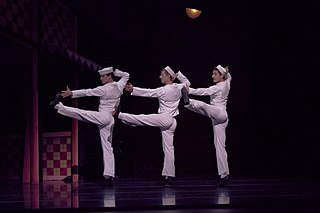Related Research Articles

New York City Ballet (NYCB) is a ballet company founded in 1948 by choreographer George Balanchine and Lincoln Kirstein. Balanchine and Jerome Robbins are considered the founding choreographers of the company. Léon Barzin was the company's first music director. City Ballet grew out of earlier troupes: the Producing Company of the School of American Ballet, 1934; the American Ballet, 1935, and Ballet Caravan, 1936, which merged into American Ballet Caravan, 1941; and directly from the Ballet Society, 1946.
Le Baiser de la fée is a neoclassical ballet in one act and four scenes composed by Igor Stravinsky in 1928 and revised in 1950 for George Balanchine and the New York City Ballet. Based on Hans Christian Andersen's short story Isjomfruen, the work is an homage to Pyotr Ilyich Tchaikovsky, for the 35th anniversary of the composer's death. Stravinsky elaborated several melodies from early piano pieces and songs by Tchaikovsky in his score. A commission by Ida Rubinstein from 1927, the ballet was choreographed by Bronislava Nijinska and premiered in Paris on 27 November 1928.
Jewels is a three-act ballet created for the New York City Ballet by co-founder and founding choreographer George Balanchine. It premièred on Thursday, 13 April 1967 at the New York State Theater, with sets designed by Peter Harvey and lighting by Ronald Bates.

Apollo is a neoclassical ballet in two tableaux composed between 1927 and 1928 by Igor Stravinsky. It was choreographed in 1928 by twenty-four-year-old George Balanchine, with the composer contributing the libretto. The scenery and costumes were designed by André Bauchant, with new costumes by Coco Chanel in 1929. The scenery was executed by Alexander Shervashidze, with costumes under the direction of Mme. A. Youkine. The American patron of the arts Elizabeth Sprague Coolidge had commissioned the ballet in 1927 for a festival of contemporary music to be held the following year at the Library of Congress in Washington, D.C.
Thou Swell is a ballet created by New York City Ballet's balletmaster-in-chief Peter Martins to the songs of Richard Rodgers in an arrangement by Glen Kelly with orchestrations Don Sebesky.
Adams Violin Concerto is a ballet made by Peter Martins, New York City Ballet's official master in chief, set to 1994 eponymous music by John Adams. The "space age quintet" ballet was commissioned jointly by the Minnesota Orchestra, the London Symphony Orchestra, and City Ballet.
Nikolaj Hübbe was artistic director of the Royal Danish Ballet until 31 October 2024 when the American Amy Watson was appointed as his replacement.
West Side Story Suite is a ballet suite choreographed by Jerome Robbins. Robbins conceived, directed and choreographed the 1957 musical West Side Story, then co-directed its 1961 film adaptation, before including parts of the choreography in the anthology Jerome Robbins' Broadway. Robbins developed the latter to the ballet West Side Story Suite for the New York City Ballet, which premiered on May 18, 1995, at the New York State Theater.

Fancy Free is a ballet composed in 1944 by Leonard Bernstein. The Ballet Theatre premiered the ballet with choreography by Jerome Robbins, scenery by Oliver Smith, costumes by Kermit Love, and lighting by Ronald Bates. The premiere took place on Tuesday, 18 April 1944 at the old Metropolitan Opera House, New York. The New York City Ballet premiere took place on Thursday, 31 January 1980. Fancy Free provided the basis for the later musical, On the Town. A portion of the score was also used in the opening scenes of Alfred Hitchcock's Rear Window.
Bugaku is a ballet made by New York City Ballet co-founder and ballet master George Balanchine to eponymous music by Toshiro Mayuzumi, commissioned by City Ballet in 1962. The premiere took place on 30 March 1963 at City Center of Music and Drama, New York, with scenery by David Hays, costumes by Karinska, and lighting by Ronald Bates. NYCB had toured Japan in 1958 and the Gagaku Company of the Imperial Household toured the US the following year.
The Chairman Dances is a ballet made by New York City Ballet ballet master in chief Peter Martins to John Adams' eponymous music from 1985. The music was originally written for Adams' opera, Nixon in China, but not used in production: the scene is that in which Mao Zedong dances with his future bride, movie star Chiang Ch'ing. The premiere took place on 14 May 1988, as part of City Ballet's American Music Festival at New York State Theater, Lincoln Center, with scenery and costumes by Rouben Ter-Arutunian, and lighting by Mark Stanley.
La Sonnambula(The Sleepwalker) is a ballet by the co-founder and ballet master of New York City Ballet, George Balanchine, made to Vittorio Rieti's music using themes from the operas of Vincenzo Bellini including La Sonnambula, Norma, I Puritani and I Capuleti e i Montecchi (1830–35).
Mother Goose is a ballet made for New York City Ballet's Ravel Festival by balletmaster Jerome Robbins to Ravel's music and scenario, the Ma Mère l'Oye Suite from 1908, orchestrated by the composer in 1912. The premiere took place on May 22, 1975, at the New York State Theater, Lincoln Center, with costumes by Stanley Simmons and lighting by Jennifer Tipton. At its premiere it bore the French title, which was retained when it was first revived in January 1978 but anglicized by May of that year.
Interplay is a ballet in one act made by Jerome Robbins, subsequently ballet master of New York City Ballet, for Billy Rose's Concert Varieties to Morton Gould's 1945 American Concertette. The premiere took place on Friday, 1 June 1945 at the Ziegfeld Theatre, New York. It was taken into the repertory of the American Ballet Theatre and presented on Wednesday, 17 October that year with costumes by Irene Sharaff. It has been revived for the City Ballet on Tuesday, 23 December 1952 at City Center of Music and Drama.

Dances at a Gathering is a ballet choreographed by Jerome Robbins to music by Frédéric Chopin, with costumes designed by Joe Eula. The ballet premiered on May 22, 1969, at the New York State Theater, performed by the New York City Ballet.
Other Dances is a ballet choreographed by Jerome Robbins to music by Frédéric Chopin. It was created on Natalia Makarova and Mikhail Baryshnikov, and premiered on May 9, 1976, at a gala benefitting the New York Public Library for the Performing Arts, held at Metropolitan Opera House. It was originally made as a pièce d'occasion, but after receiving critical acclaim, it was soon added to American Ballet Theatre and New York City Ballet's repertories.

Prodigal Son, or Le Fils prodigue, Op. 46 is a ballet created for Diaghilev's Ballets Russes by George Balanchine to music by Sergei Prokofiev (1928–29). The libretto, based on the parable in the Gospel of Luke, was by Boris Kochno, who added a good deal of drama and emphasized the theme of sin and redemption ending with the Prodigal Son's return.
Liebeslieder Walzer is a two-part neoclassical ballet choreographed by George Balanchine to Johannes Brahms' Liebeslieder Waltzes, Op. 52 and Neue Liebeslieder, Op. 65, with original sets and lighting designed by David Hays, and costumes designed by Barbara Karinska. The ballet premiered on 12 November 1960 at the New York City Center, performed by the New York City Ballet.
Amy Watson is an American ballet dancer. She joined the Royal Danish Ballet in 2000, becoming a principal dancer in 2007. In 2011, she was honoured with the prestigious Order of the Dannebrog, and in 2021 made a Knight 1. Class. On 31 October 2024, Watson was appointed artistic director of the Royal Danish Ballet, replacing Nikolaj Hübbe.
Divertimento No. 15 is a ballet choreographed by George Balanchine to Mozart's eponymous music. The ballet was made for the New York City Ballet. Balanchine first choreographed the score in 1952, for a ballet titled Caracole. In 1956, he planned to revive Caracole for a celebration of Mozart's bicentenary but made a new ballet to the same music instead. Divertimento No. 15 premiered on May 31, 1956, at the American Shakespeare Theatre, Stratford, Connecticut.
References
- ↑ "Zakouski". New York City Ballet. Retrieved November 1, 2024.
- Playbill, New York City Ballet, Thursday, January 3
- Repertory Week, New York City Ballet, Winter Season, 2008 repertory, week 1